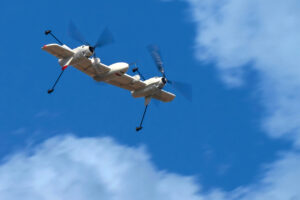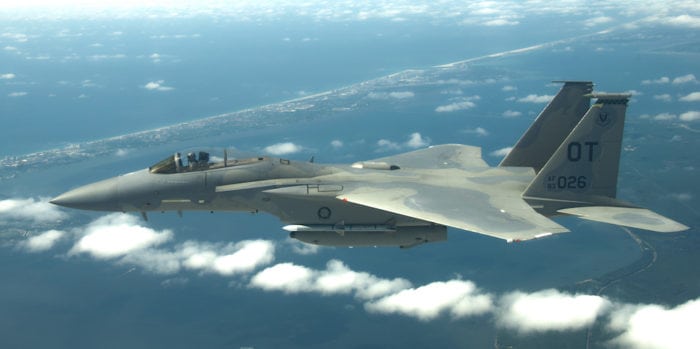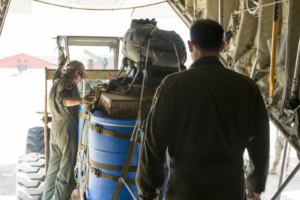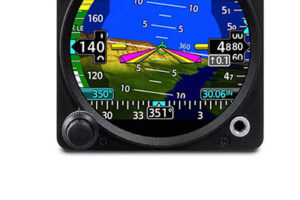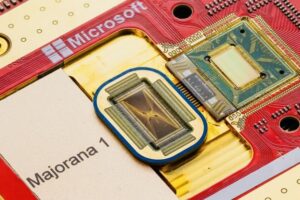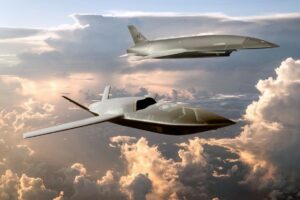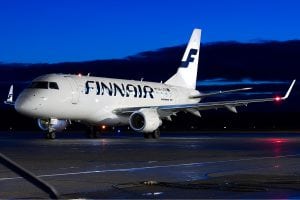Link 16, like many other U.S. military radio frequency (RF) applications, is being integrated into the software-defined radio architecture developed by the Joint Tactical Radio System (JTRS) program. This tactical data link will rely on core architectural elements from JTRS Cluster 1 and a JTRS version of the Link 16 waveform. The program integrating Link 16 into JTRS also will consolidate front-end hardware, repackaging Cluster 1 components in a much smaller form factor.
These incremental improvements, however, could be dwarfed by superconducting electronics (SCE). If SCE can overcome a host of challenges, it could eliminate much of the analog processing chain and bring operational benefits to this tactical network.
Link 16 is used to communicate targeting, track, and command and control data among groups of aircraft. BAE Systems is converting the complex Link 16 waveform to a JTRS-compliant signal under the JTRS Cluster 1 and the Multipurpose Information Distribution System (MIDS) JTRS programs. MIDS JTRS aims initially to field this Link 16 waveform on two airplanes, the Navy’s F/A-18 Super Hornets and the Air Force’s A-10s. The first Super Hornets are to have the equipment by January 2009.
A JTRS-compliant, software Link 16 waveform would be advantageous. It would make the waveform more independent from the hardware and easier to upgrade. In the current Link 16 box, the low-volume terminal, LVT-1, “hardware and software are very closely coupled,” points out David Erusha, co-director (on the Rockwell Collins side) of Data Link Solutions (DLS). DLS, a joint venture of BAE Systems and Rockwell Collins, is one of the teams developing components for MIDS JTRS. Changing the software often affects the hardware, and vice versa, he says.
Last December ViaSat and Data Link Solutions won two MIDS JTRS development awards. In 2007 the teams are to deliver 20 production verification terminals. The radios would run a JTRS-compliant, Link 16 waveform in one channel and demonstrate that they can run a JTRS-compliant version of the Army’s single-channel ground and airborne radio system (SINCGARS) waveform to test one of the remaining 2-MHz-to-2-GHz channels. The radio would be able to accept additional, requested JTRS waveforms in the wideband channels when and if the services request them.
The MIDS JTRS radio would be far more advanced than MIDS LVT-1, which is a single-channel radio that runs only Link 16, a tactical navigation (TACAN) system and voice. The catch is that all this new functionality, plus hooks for growth, must fit into the existing, 0.6-cubic-foot volume, a fact that is driving hardware consolidation.
Within DLS, Collins is designing the 2-MHz-to-2GHz-band transceivers for the universal channels, says Erusha. The company intends to repackage its Cluster 1 transceivers, which have been tested to a pre-engineering development model (prototype) level of maturity.
The Link 16 transceivers, essentially the RF front-end of the radio, would shrink in size, so that four of them could be squeezed onto a single SEM-X card instead of dispersed across two shop replaceable units (SRUs), as they are in the current LVT design. Collins also plans to combine receiver, synthesizer and exciter functions into the transceiver. Two receivers are necessary for each antenna to synchronize Link 16 messages. Keeping up with the signal’s hopping speed is a factor, but the driving requirement is the need to “listen ahead,” while simultaneously receiving the current pulse during the synchronization process. Hardware consolidation here and elsewhere in the transceivers would allow three “2-to-2” channels to be added within the existing space.
Though it’s narrower in scope than Cluster 1, MIDS JTRS is not risk-free. Apart from crucial dependencies on Cluster 1, the program is on a tight schedule and is moving ahead at the same time that a new JTRS Joint Program Executive Office (JPEO) is examining program-wide interoperability and affordability issues.
Beyond Silicon
But what if the Link 16 RF waveform could be converted to digital directly at the antenna? “Direct digital conversion” of RF energy into “1s” and “0s” at the antenna would eliminate most of analog processing that today’s (and even tomorrow’s) radios require to downconvert the RF signal to the lower intermediate frequency (IF) appropriate to a conventional analog-to-digital converter (ADC).
Superconducting electronics promises just this. The Office of Naval Research (ONR) and the Army’s Communications Electronics Research, Development and Engineering Center (CERDEC) are funding work on the components that will be needed to build and test such a radio. Much of the research concerns the ADC, a component which grabs, or samples, analog energy and produces a digital representation of the signal that is then digitally processed.
Conventional radio receivers “throw away the spectrum” outside the band of fixed width about the frequency of interest, says Deborah Van Vechten, program officer for SCE at ONR. Conventional receivers have to downconvert, or move the signal’s center frequency—the RF carrier that is modulated with information signals—and reduce its bandwidth, in order to make the signal digitizable. “You may get the signal you were aiming to get in the first place, but you have to go back to the analog world, with a different mixer and local oscillator signal [analog components], to bring down a different segment of the spectrum. You end up with a federated receiver, where every signal you want to process at the back end requires a separate analog front end, a separate processing chain.”
SCE uses a fundamental device that is totally different from a transistor. Known as Josephson junctions (named after a British physicist), these devices respond to RF energy by outputting electrical pulses, which are interpreted as “1s.” The logic is clocked at the picosecond (billionth-of-a-second) level, and when no pulse arrives at the proper time, it is interpreted as a “0.” The science is well enough understood and the technology, mature enough, that a system marketed by Hypres Inc., Elmsford, N.Y., is used as the basis of the world’s voltage standard. The catch—and it’s a big one—is that SCE systems have to operate at temperatures near 4 degrees Kelvin (K), the temperature at which liquid helium boils. But that challenge only energizes advocates, who are funding multiple cryopackaging programs.
Digital Dehopping
Hypres has numerous SCE projects, including an All-Digital Receiver (ADR) prototype for ONR and several band pass (band-limited) ADC prototypes for CERDEC. The CERDEC work includes an L-Band ADC for Link 16 and an X-Band ADC for satcom. The company also has proposed a program to ONR to demonstrate “digital dehopping.” Digital dehopping is a made-up term that refers to the potential to capture and process the data in the hopping Link 16 signal as easily as if it didn’t hop at all. In reality, it hops through 51 subbands at more than 77,000 times a second.
“A major cost driver for radios equipped to handle Link 16 is the need for extensive analog processing to track the hopping signal, process it and analog up- or downconvert it to a single intermediate frequency that the analog-to-digital converter in the modem can see,” says Richard Hitt, Hypres’ general manager. “The backside of our conversion process is I&Q [in-phase and quadrature] data,” a higher-fidelity digital replica of the signal than today’s analog, front-ends can produce, he says.
In its L-Band ADC program with CERDEC, Hypres is developing an ADC that accepts the entire military L-Band, particularly all the bands where Link 16 resides. This includes: 960-1017.5 MHz, 1042.5-1077.5 MHz, and 1102.5-1215 MHz. A “sharp-skirted analog filter” being designed at ONR could notch out intervening strong signals—identification-friend or foe (IFF) and others—in the 1017.5-1042.5-MHz and 1077.5-1102.5-MHz bands, if they prove to be problematic.
Each of these Link 16 bands would be directly digitized simultaneously to produce a single digital reconstruction of the total signal, Van Vechten says. Thus any of the 51 Link 16 subband signals simultaneously present would be captured.
The superconducting ADC samples the RF signal very accurately at clock speeds of 20 GHz or more, Van Vechten says. The 20-GHz ADC samples the Link 16 carrier waveform at 20 times per RF cycle. Each ADC sample produces 1 bit of data. RF mathematics, meanwhile, calculates that sampling at only twice the frequency is enough to accurately convert an RF signal to digital form. Moreover, the information in the signal is conveyed at a much lower frequency than the RF carrier. Thus, the SCE electronics’ massive “oversampling” produces so much single-bit data that, even when averaged or filtered, it produces more accurate data than a conventional silicon ADC, she explains.
The beauty of this oversampling is that you can accurately and simultaneously receive far more bandwidth than a single signal. This means that the bandwidth could be used to realize voice-over-Internet-protocol (VOIP) and other signal layering techniques for increasing communications capacity.
The single bits of data can be averaged to produce more bits of accurate data while at the same time removing initially in-band noise, Van Vechten says. Hypres in 2002 demonstrated, by narrowband digital filtering, the elimination of noise present in the initial wideband data but outside the final pass band. SCE is the only digital technology to have demonstrated this achievement to date, Van Vechten says.
Monitoring Work
ONR has selected Hypres to perform another Link 16-related research project. When this project is awarded, Hypres, as prime, will partner with ViaSat, which manufactures Link 16 terminals and monitoring equipment. Even though, theoretically, more than 100 Link 16 nets can operate simultaneously in the same geographic area without interfering with each other, the limitations and the cost of today’s single-net terminals restrict the number of simultaneous nets used operationally.
Hypres expects to design an SCE-based, multichannel front-end for the ViaSat system, so that more nets could be monitored simultaneously. ONR plans to combine a 20-GHz, L-Band ADC designed for the Army and a cross-correlator designed for the Navy, and to develop a digital template to represent the Link 16 frequency as it changes in time. The project must determine how best to produce such a template and in what format to get superconducting data into the room temperature ViaSat electronics, Van Vechten says. The cross-correlator is a digital component at the back end of the ADC that compares the digitized broadband data with the hopping pattern to pick out any Link 16 signals in those large chunks of spectrum. It’s like putting one hand over the other and matching the knuckles, or time-dependent RF amplitudes, to each other, she explains. To monitor multiple Link 16 nets simultaneously, designers would have to use multiple, SCE-based cross-correlators and a template for each cross-correlator. However, all these parallel, digital filters can be driven by a single ADC and a set of analog components.
If Hypres succeeds, the military person in charge of monitoring Link 16 nets—there is one for all forces in each geographical area—would be able to switch at will among the different nets and see as many of them as he cares to in real time, Van Vechten asserts. If all forces had such a unit and the transmit side is also improved, more Link 16 networks, operating at higher capacity, could be used simultaneously, and some could be reserved for relay functions, thereby dramatically increasing the effective communication capacity of the Link 16 system.
Cryocooler
But the long pole in the tent is cooling.Under a two-year award from the CERDEC, Hypres is developing a prototype, compact tactical cryocooler that would deliver the required 4-degree K environment for the chips in a box small and light enough to meet JTRS Cluster 1 requirements.
Cryocoolers, which include a compressor to move the refrigerant and a “cold head,” on which the chips and wiring are mounted, are now large. Hypres’ All-Digital Receiver project for ONR uses a commercial cooler that is 60 inches high, 19 inches wide and 24 inches deep. But the company wants to shrink the total cooling package to 12-by-10-by-24 inches.
SCE developers will need to minimize the “parasitic” heat from the lines that bring the signal down from the antenna and take the data back up to room temperature. It would be inefficient to have a single size and type of wire going from 300 degrees K to 4 degrees K, says Van Vechten. Heat should be removed at the intermediate stages, and optimal materials should be selected for each temperature step. This and other ideas to reduce the heat load on the 4-degree K stage are being investigated at ONR. The aim is to increase the cooler’s functionality or to shrink its size.
AJCN: A Node for C4ISR
Another project using software-defined radio technology is the Adaptive Joint C4ISR Node (AJCN). (C4ISR stands for command, control, communications, computers, intelligence, surveillance and reconnaissance.) AJCN is an advanced concept technology demonstration (ACTD) heading toward an operational assessment in September.
The technology demonstration is the third phase of a Defense Advanced Research Projects Agency (DARPA) program. Over time it has morphed from a com relay node to a multimission node, performing signals intelligence (SIGINT), communications, electronic warfare (EW) and information operations. As a communications application, AJCN uses several software-modulated waveforms: a JTRS-compliant version of the U.S. Army’s single-channel ground and airborne radio system (SINCGARS) signal, a GSM base station, and VHF AM and FM signals. The demonstration will use conventional AM, FM and enhanced position locating reporting system (EPLRS) radios, as well. The payload runs two types of infrastructure software—JTRS for communications and prime contractor BAE’s Diamond framework for SIGINT.
The hardware receiver architecture reflects SIGINT’s need for wideband signal search. The antennas, segregated by frequencies, cover a band of spectrum from 30 MHz to 3 GHz. The 25-MHz tuners that select the channels of interest can be dynamically controlled in software and reassigned over that band. Or their output can be “stitched together” to support signal surveillance over a wider band. Processing resources are shared among multiple missions.
“We have shared tuners,” says Jeffrey Keehn, chief of the Special Projects Office for Space and Terrestrial Communications at the Army’s Communications Electronics Research, Development, and Engineering Center (CERDEC), a cosponsor of the ACTD. “The remaining portion of frequency in the tuner is available for use by another channel.”
AJCN uses separate transmit and receive antennas that are intended to operate simultaneously. You could do SIGINT on the receive side while you do communications on the transmit side, says Dick Ugolini, BAE Systems’ program manager for information warfare. Interference cancellation is key. It includes careful location of the various antennas (which ideally would be highly directional), signal cancellation and null steering.
The joint operational assessment at Fort Huachuca, Ariz., in September will employ two Hunter unmanned air vehicles (UAVs) at about 12,000 feet and the Paul Revere, a Boeing 707-based electronics testbed aircraft operating at about 22,000 feet. The Hunter can carry a 270-pound (122.5-kg) payload, supporting up to five simultaneous transmit and receive channels, with 10 antennas. The Paul Revere can carry a payload of up to 1,500 pounds (680.5 kg), which uses 21 antennas and provides up to 15 simultaneous channels.
Among the experiments planned for the month-long exercise will be a SIGINT search to identify various radio signals being transmitted in the Fort Huachuca area. A follow-on to that would be to not only identify the coms, but jam them. In a third experiment someone would drive a vehicle from Fort Huachuca to Tucson, a 90-mile trip, while maintaining a continuous link through the AJCN to the tactical operations center.
AJCN would not replace dedicated SIGINT and EW, but complement “low-density/high-demand” assets, such as the Army’s Tactical SIGINT Payload. The Army is particularly interested in the interference cancellation technology and some of the antenna work, Keehn says.
One can imagine AJCN flying over the battlefield in a large manned aircraft or UAV. It would identify the different signals in the area and relay communications from one part of the battlefield to another, while at the same time transmitting an EW or distortion signal to jam or confuse enemy communications or deny certain areas of the spectrum. It could, for example, jam the cell phone frequencies in a particular area, thus preventing the remote detonation of improvised explosive devices.



